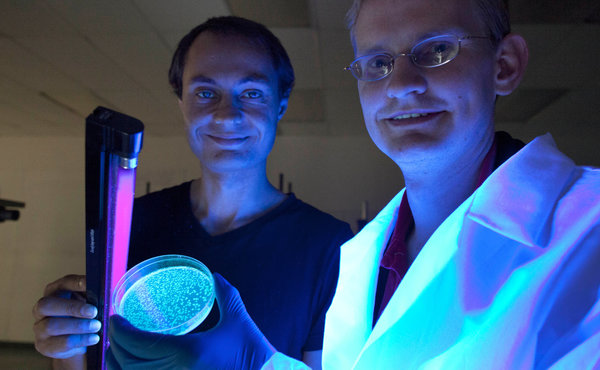‘Glowing Plants‘ is a kickstarter project which is set to create the first publicly available bioluminescent plants. To do this, they will be adding the luciferase-luciferin gene system into the model organism Arabidopsis thaliana. Expanding on previous work done by the State University of New York and the University of Cambridge iGEM team, this synthetic biology project is truly exciting. What makes this project different is how widespread these plants will be disseminated, with over 5000 backers already. This project is the most successful biological crowdfunded campaign ever, and is setting a precedent for future projects which might seek funding this way.
I was lucky enough to get an interview with Antony Evans the project manager of Glowing Plants. Check out the kickstarter video for glowing plants and our exclusive interview after the break.
About the Project
Synthetic Bestiary: Lets start at the beginning. When did your group come up with the idea to create widely distributed glowing plants and what were the origins of this project? Has the project been in the works for a long time and how much work has it taken to get as far as you have?
Antony Evans: Glowing plants have been used by academic researchers for a long time. The 2010 University of Cambridge iGem team were the first to suggest they could be used for Street Lighting. This team has been working on the project for eight months.
Synthetic Bestiary: You talked about your vision for the future, where streetlights are replaced with glowing trees. Obviously your project is just the first step on the path towards practical applications, but where do you think we will be in the next 5, 10, and 25 years towards this goal? You commented that the following arstechnica article was bad journalism, could you elaborate on what they got wrong?
Antony Evans: I probably shouldn’t have written that comment, but I believe if you want to write a negative article about someone then you should contact them first – he sent us a tweet about 20 minutes before publishing which isn’t really a good way to get in touch, every other journalist has got in touch with us.
There are three things wrong with the article:
- We are not using Firefly luciferin system (he has redacted this section already)
- The energy calculations have several flaws:
- He compares street lights (10k lumens) with estimates of plant luminosity (lumens per square meter) implying a comparison between items with different units. A typical street has a lot of square meters of plants
- Many of his estimates are unduly pessimistic, the most egregious is the 5% efficiency. Luciferine-luciferase is known as cold light because there is zero waste energy (ie 100% of the energy is converted to light)
- He states we should just get our sequences from researchers for free rather than synthesising. This is fundamentally flawed as the whole point of the project, improving on the New York work, relies on us Codon optimizing the sequences for plants. DNA synthesis is now cheaper than manual construction of sequences.
Synthetic Bestiary: Recently there has been some controversy about your project in terms of environmental risk, with activists coming out against the project. Do you think these allegations are entirely based on a misunderstanding of the science, or should there be more oversight on projects like these? What is your own team’s plans to test the environmental impact of your product?
Antony Evans: Their central allegation is not that this project is risky, but that the US Federal government should regulate what we are doing (they currently do not). That’s obviously a perfectly valid point of view and it’s appropriate to have a discussion about what should and shouldn’t be regulated. We are convening an advisory board of experts who will review the environmental impact of the plant. George Church, head of genetics at Harvard Medical School, and John Ward, Professor of Synthetic Biology at University college London, have both gone on records saying this is a safe project. Personally I think what we are doing (non-toxic genes, no selective advantage, not food) is as safe as it gets and therefore imposing a significant cost burden due to regulation would be an unnecessary barrier to innovation in the field.
Synthetic Bestiary: Your project has a number of references to education, including your offerings of maker kits a class visits in your rewards. What are the educational benefits of this project in your eyes and how do you intend to support teachers who wish to use your product in the classroom?
Antony Evans: The biggest benefit is that we raise awareness of the capabilities of this technology, and demonstrate how easy it is to do this. We are already talking with a number of teachers and will continue to do so.
Crowdfunding And Success
Synthetic Bestiary: Choosing to use Kickstarter was obviously an important decision for your project, can you elaborate on your reasons for choosing this platform for your project and how it shaped the way you planned things out?
Antony Evans: This was probably not a project which would have attracted academic research funding, as the science is not cutting edge, nor commercial venture funding, as the market is too immature, so crowdfunding was our only option. We chose kickstarter because they are the leading platform and generate the most traffic to our project.
Synthetic Bestiary: There has been some skepticism in the past as to the usefulness of crowdfunding for biotech projects, given how much money they need to raise. Do you think crowdfunding can overcome those barriers, or will there always be a high reliance on external funding sources for this kind of work?
Antony Evans: I think crowdfunding is most useful at the start of a project. Say someone has a risky new idea for a drug or other treatment but there isn’t enough data to know if it is worth the risk. People with that disease might be willing to fund that trial, and maybe this can lead to more drugs. There haven’t been many failures yet so it will be interesting to see what happens in the future and how the public will react to riskier project like new drugs – many of which will fail.
Synthetic Bestiary: Your project has already been hugely successful, blowing through your goal of $65,000 and at the time of writing passing $300,000! You’ve set up a stretch goal for glowing roses at $400,000, do you have plans for further stretch goals beyond that? Did you anticipate the huge amount of positive support your project has gotten, and what do you think was the key to your success?
Antony Evans: The key to success with crowdfunding is luck and market research. I doubt you can predict what will be a hit, but we did a lot of user feedback (over 100 interviews) to make sure the messaging and reward pricing was just right. To many projects don’t do this and you know they are doomed from the beginning as they are too technical or the rewards are too expensive or not interesting. Our early drafts were terrible as well but thanks to lots of people’s help we iterated into something people really wanted.
Following in Your Footsteps
Synthetic Bestiary: Your success has thrown you into the limelight as a rolemodel for future synthetic biology projects in this field. What advice would you give young entrepreneurs, scientists, and enthusiasts who want to create their own crowdfunded synthetic biology projects?
Antony Evans: Go for it! Don’t underestimate the amount of work in getting to the start line, but it’s been the most rewarding professional experience of my life. Seeing enthusiasm from backers for something you create is fantastic and will fuel us on through out the project.
Synthetic Bestiary: For even younger enthusiasts, what would you recommend as the pathway to being involved in this field? What should our next synthetic biologist entrepreneurs be studying at university and where in the world should they go to get access to the expertise and colleagues they need to do these things?
Antony Evans: Advice is no different to any other field. Surround yourself with the right people, focus on doers not talkers. If I was 18 and about to go to university again I’d be looking to study biology or genetics – the top schools in the field are the same as the names you already have heard of. I’d recommend people get outside the academic sphere though, there are some great things happening in DIY Bio labs around the world and that’s where you find the doers so I’d get involved.
Synthetic Bestiary: You yourself were a member the GSP 2011 program with Singularity University, how has Singularity University supported your project so far?
Antony Evans: Hugely supportive. I met Omri through the program, and they helped us with mentoring and support, lent us a room for a launch event introductions to mentors/journalists and a network of other people who have done projects before us. The last point is really important – when you see a friend succeed on kickstarter you start to think ‘I could do that too’ and it becomes a virtuous cycle.
Radical Openness
Synthetic Bestiary: Your project has a huge emphasis on openness, could you walk us through why you think this is so important and how you are going to make sure your project is open in the ways that matter?
Antony Evans: Openness achieves three goals:
1. Educates people about what we are doing
2. Holds us accountable to backers
3. Provides a basis for real-time peer-review and collaboration – this should accelerate the field
Synthetic Bestiary: You opened up an open poll to your supporters as to what they would like to see as the commercial licensing for your glowing seeds and the vote came back as completely open, allowing companies to sell. Can you walk us through what that means for your project and why you chose to decide this issue through a public poll? What are your opinions on the necessity or lacktherof for gene patenting in this industry?
Antony Evans: It was a change of policy, we had previously promised backers we wouldn’t sell the plant so if they wanted to change that it had to come from them otherwise it would have seemed indigenous. Our backers are to some degree our investors, and so I think their views should be represented in the project.
I’m against patenting the ownership of genes. I think patents reward big companies and inhibit innovation. I wrote about my views here.
Synthetic Bestiary: A lot of the bad reputation biotech has comes from large companies like Monsanto. In contrast your group is one of the first small commercial biotech groups. How do you think we can change the bad perceptions Monsanto and other big biotech companies have created, and what do you see the future being for small biotech companies?
Antony Evans: We can change perceptions by showing theirs a better way of doing things. Corporate control of agribusiness is what has given GMO a bad name, and is one of the drivers for us taking a more open approach to this kind of work.
Into the Future
Synthetic Bestiary: What is the future for your group after this project? Will you be back on Kickstarter again with another product anyone can contribute to, or do you want to go in a different direction?
Antony Evans: For now we are focused on fulfilling the obligations we are committed to, we’ll figure out the next step down the line when the time comes.
Synthetic Bestiary: Your product is one of the first “consumer” focussed biotech products, as opposed to industry products, do you think we will see more biotech products regular households can purchase in the near future?
Antony Evans: Absolutely. This stuff is going to be common place in a few years. Look at the creativity of the iGem teams for inspiration of what is possible.
You can find out more about the Glowing Plant Project at their Kickstarter page.




















あなたが本当にしたい場合は、他の方法を見て、それについて話すことはできません。本当の真実は、自分自身と自分の目標に正直が付属しています。一般に、これは誤解や非生産的な生活につながります。
私はこのウェブサイトは、いくつかの時間前にブックマークしていたが、私のラップトップがクラッシュしました。私は以来、新しいものを得ている、それはこれを見つけるために私に時間がかかりました!私も実際にもデザインが好きです。